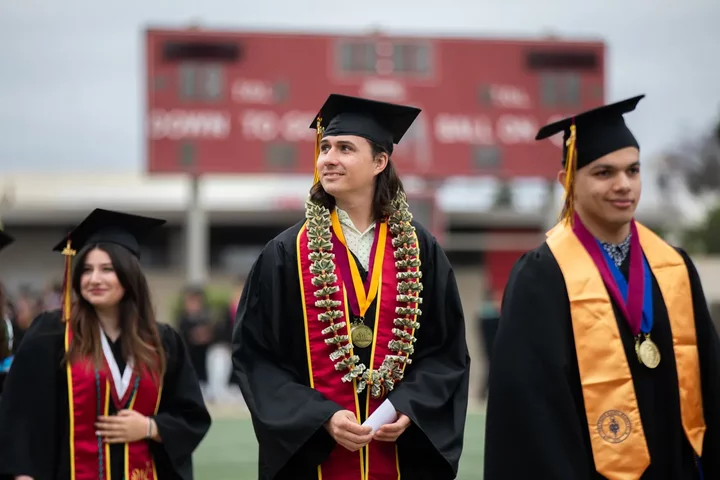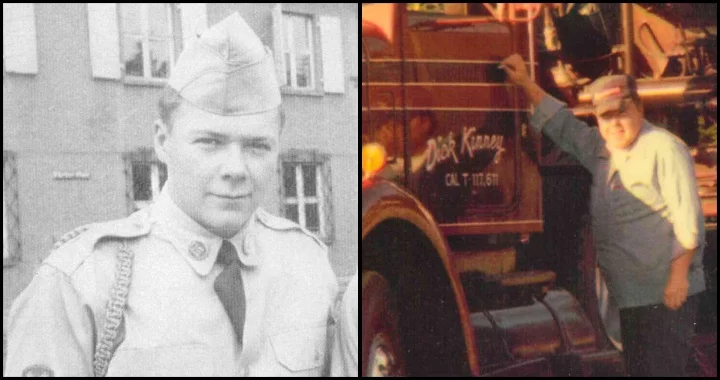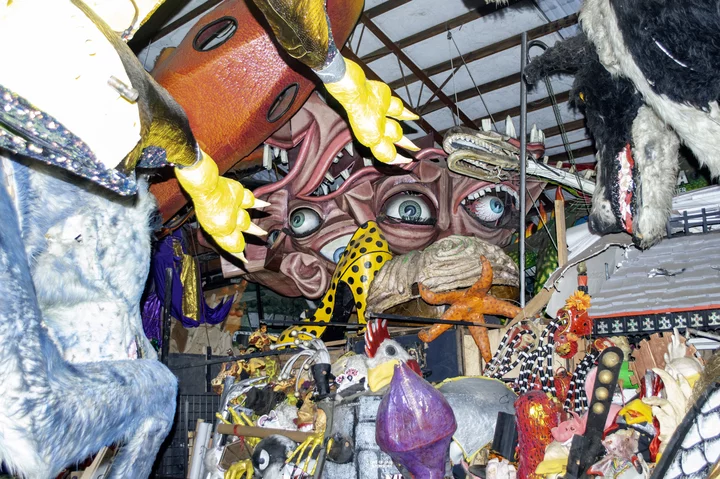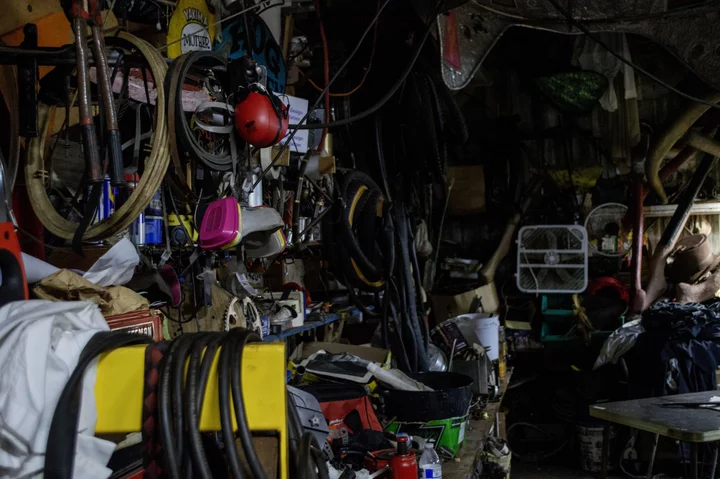THAT’S A LOTTA TURKEY! Rotary Club of Eureka Donates Hundreds of Birds During Record-Setting Holiday Turkey Drive
LoCO Staff / Tuesday, Dec. 16, 2025 @ 3:32 p.m. / Feel Good , Food
Left to right: Rotary Club of Eureka President Dale Warmuth, Executive Director of the Eureka Rescue Mission Bryan Hall, and the turkey drive organizer himself, Matthew Owen. | Photo: Rotary Club of Eureka
###
Press release from the Rotary Club of Eureka:
EUREKA, CA — This holiday season, the Rotary Club of Eureka is giving back with its annual turkey drive. The club has already donated a record 239 turkeys to local organizations and expects to give out even more before Christmas. The annual turkey drive, now in its tenth year, aims to ensure that families throughout Eureka have the resources to enjoy a holiday meal.
Volunteers from the Rotary Club delivered turkeys to eight nonprofit organizations serving individuals and families in need. The largest share went to the Eureka Rescue Mission, which received 100 turkeys. Additional recipients included Food for People, the Betty Kwan Chinn Foundation, St. Vincent de Paul, Salvation Army, Jefferson Community Project, Redwood Teen Challenge, and the Boys & Girls Club of the Redwoods. “All the funds raised for this turkey drive came directly from our members,” said Rotary Club of Eureka Dale Warmuth. “Supporting our community, especially during the holidays, is very important to us. Our members know this is a challenging year for so many people, and they really stepped up to help.”
Leaders from partner organizations expressed their gratitude. Bryan Hall, Executive Director of the Eureka Rescue Mission, reported that the turkey donations helped the Mission distribute 122 food boxes and serve 342 meals for Thanksgiving. Carly Robbins, CEO of Food for People, added, “We are exceptionally grateful to the Rotary Club of Eureka. The donation of these turkeys helped us provide food for a holiday meal to families at a time when many are struggling to make ends meet.”
The Rotary Club of Eureka is planning to donate more turkeys in time for Christmas. The turkey drive is part of the Rotary Club’s longstanding focus on humanitarian service both locally and globally. Members hope their efforts will inspire others in the community to lend a helping hand throughout the holiday season. To learn more about the Rotary Club of Eureka or to make a donation, visit www.rotary1.org.
BOOKED
Today: 4 felonies, 8 misdemeanors, 0 infractions
JUDGED
Humboldt County Superior Court Calendar: Today
CHP REPORTS
No current incidents
ELSEWHERE
County of Humboldt Meetings: Behavioral Health Board Executive Committee Meeting - Nov. 5, 2025
Governor’s Office: One year after Los Angeles firestorms, California continues statewide recovery and behavioral health support
Fishing the North Coast : Dry Stretch Sets the Stage for Prime Steelhead Conditions
Governor’s Office: Governor Newsom delivers final State of the State Address, honoring California’s past and reaffirming a brighter future for all
Republicans Ask Federal Court to Overturn California’s New Prop. 50 Maps
CalMatters staff / Tuesday, Dec. 16, 2025 @ 2:36 p.m. / Sacramento
A “No on Prop 50” sign at the Kern County Republican Party booth at the Kern County Fair in Bakersfield on Sept. 26, 2025. Republicans are seeking to overturn the congressional maps voters approved last month. Photo by Larry Valenzuela, CalMatters/CatchLight Local.
###
This story — written by Maya C. Miller and Mikhail Zinshteyn — was originally published by CalMatters. Sign up for their newsletters.
###
Just last week California’s secretary of state officially certified that more than two-thirds of Californians voted to pass Proposition 50, Gov. Gavin Newsom’s plan to temporarily gerrymander the state’s congressional maps in favor of Democrats.
Nevertheless, Republicans and the Trump administration are hopeful that a federal district court panel meeting in Los Angeles this week will intervene to bar the state from using the new maps next year.
California Republicans, who sued Newsom and Secretary of State Shirley Weber the day after the election, are staking their challenge on the argument that California’s primary mapmaker illegally used race as a factor in drawing district lines, giving Latino and Hispanic voters outsize influence at the expense of other racial and ethnic groups, including white voters.
This, the Republicans argue, means the maps amount to an illegal racial gerrymander and a violation of the 14th and 15th amendments. Although Section 2 of the federal Voting Rights Act allows for race-conscious redistricting, they add, case law and judicial precedent have set a strict standard that requires a minority group to prove they have been systematically outvoted by a majority that consistently votes together to deny the minority their chosen candidate.
But the Prop. 50 opponents’ odds look slim, especially after the U.S. Supreme Court’s conservative majority recently blessed Texas’s new maps, overturning a lower court’s finding that Republicans there had engaged in unconstitutional racial gerrymandering.
“It is indisputable that the impetus for the adoption of the Texas map (like the map subsequently adopted in California) was partisan advantage pure and simple,” wrote conservative Justice Samuel Alito in a concurring opinion supported by Justices Neil Gorsuch and Clarence Thomas.
And then there’s the looming possibility that the Supreme Court, in a separate case, could outlaw entirely the use of race in the redistricting process, which could render California’s new maps — as well as the previous ones drawn by the independent citizens commission — unconstitutional. That would also give Republicans a major advantage in Southern states, where several districts drawn to increase Black Americans’ voting power are currently represented by Democrats.
Despite the long odds, the ailing California GOP has run out of other options for resistance. The passage of Prop. 50 is likely to mark the beginning of the end for several of California’s Republican House members, who have been forced to decide whether to run in their current, now less favorable Republican districts, switch to new seats or drop out entirely.
One of them, Rep. Darrell Issa, who represents parts of San Diego County, even considered relocating to Texas and running for a Dallas-area seat that would be more friendly to Republicans, but the president reportedly refused to endorse him for the already contested Texas seat, so he decided to stay.
The legal challenge claims the Prop. 50 maps cause “stigmatic and representational injury” by placing certain candidates, such as Republican Assemblymember David Tangipa of Fresno, who is Polynesian, into districts drawn with a specific racial or ethnic minority group in mind.
Case is in Los Angeles court this week
The challengers, who include Tangipa, the California Republican Party, several Republican voters and the Trump White House, are asking a three-judge panel for the Central District of California to grant a preliminary injunction on the maps before Dec. 19, the date when candidates can start collecting signatures to get their names on the 2026 primary ballot. A preliminary injunction would temporarily prevent the maps from being used in an election.
On Monday in court, the Republican challengers presented their case, arguing that since supporters of Prop. 50 publicly touted that the maps increased representation for Latino voters, state lawmakers and consultant Paul Mitchell, who was hired to draw the maps, took race into account. Therefore, they must justify how their new districts meet the standard for permissible racial gerrymanders, attorneys argued.
“It is legal to race-based redistrict under the Voter Rights Act. Section 2 protects it. But it also gives you guidelines,” Tangipa told CalMatters in an interview after testifying in court on Monday in Los Angeles. “In Sacramento, they did not follow those guidelines.”
Tangipa asserted that even though Democratic lawmakers intended primarily to increase their party’s ranks based on political ideology, “They used race to justify that end goal.”
The plaintiffs sought to have Mitchell testify, but the court denied a request to force him to take the stand to explain whether he intentionally tried to increase the voting power of specific racial and ethnic groups. Since Mitchell lives more than 100 miles away from the court, he was out of the reach of a subpoena. Still, the judges questioned his blanket use of “legislative privilege” to resist producing documents the plaintiffs requested.
At one point, as a redistricting expert testified, the plaintiffs focused on a line from Democratic former Senate President Pro Tem Mike McGuire’s public statement after the Legislature passed the package of bills paving the way for the Nov. 4 special election.
“The new map makes no changes to historic Black districts in Oakland and the Los Angeles area, and retains and expands Voting Rights Act districts that empower Latino voters to elect their candidates of choice,” McGuire’s statement said.
McGuire announced last month that he will challenge Republican Rep. Doug LaMalfa in one of the newly configured Prop. 50 seats.
But proponents of the new maps argue they intended purely to create a partisan advantage for Democrats, and any increase in voting power for certain ethnic or racial groups was incidental.
Ultimately, ‘it was endorsed by the voters’
Also complicating the GOP’s challenge is that California voters overwhelmingly approved the maps.
“Even if we assume that the Legislature improperly considered race, ultimately it went into effect because it was endorsed by the voters,” Emily Rong Zhang, an assistant professor of law at the University of California at Berkeley School of Law, previously told CalMatters. “They would have to show that the voters had the intent to create districts that disproportionately favor the voting power of a racial group over another.”
One unknown is how the Supreme Court will rule on a case that questions whether it’s constitutional to even consider race as a factor when redistricting.
The justices are weighing in another ongoing case, Louisiana v. Callais, whether to strike down a part of the federal Voting Rights Act that requires the creation of districts in which racial and ethnic minorities have a chance to elect their preferred candidate. If the ruling is retroactive, a decision to strike it down could invalidate both California’s old and new maps.
Regardless of how the Supreme Court rules, other states have jumped into the redistricting effort or are contemplating entering the fray. In addition to Texas and California, four other states have already implemented new congressional maps, according to the National Conference of State Legislatures. Virginia, Maryland and Florida have also taken some steps toward redistricting.
More Adults Return to College in California as Inflation and Job Fears Rise
Adam Echelman / Tuesday, Dec. 16, 2025 @ 7:32 a.m. / Sacramento
Graduating students walk into the DeVore Stadium during a commencement ceremony at Southwestern College in Chula Vista on May 24, 2024. Photo by Adriana Heldiz, CalMatters
###
This story was originally published by CalMatters. Sign up for their newsletters.
###
If you want to gauge the health of California’s economy, start with its community colleges.
“When the economy is doing well, our enrollments are down, and when the economy is in a tough stretch or in a recession, we see our enrollments go up,” said Chris Ferguson, an executive vice chancellor with the California Community Colleges Chancellor’s Office, which oversees all of the state’s 116 community colleges.
Ferguson said the state has yet to release authoritative data on fall enrollment, but early data shows upward trends. In interviews with CalMatters, some college presidents said they’re seeing over 10% more students compared to last fall. But they say the state hasn’t provided enough funding to keep up with their growth.
California is not in a recession, but some economic indicators are grim. Unemployment is rising, and it’s getting harder to find a job. The cost of consumer goods, such as toilet paper and cosmetics, is going up, and economists say tariffs and President Donald Trump’s increased deportations could lead to further economic declines in the state.
“Typically when the economy gets a little crazy, like it is right now, people need to upskill or find new work,” and workers look to colleges for help, said Nicole Albo-Lopez, deputy chancellor for the Los Angeles Community College District. In the Los Angeles district, students between the ages of 35 and 54 are coming back to school in droves — up 28% compared to last year, she said.
Other factors may also be bringing students back to school. The COVID-19 pandemic created a sudden and historic drop in college enrollment, and some schools say the influx of students this year is just a return to pre-pandemic levels. A large portion of recent enrollment growth comes from high school students taking college courses, which has exploded in popularity in the past few years.
But most college officials agree that uncertainty about the economy is at least one of the driving forces for new students this semester.
At the Los Rios Community College District, which represents four campuses in the Sacramento metro area, enrollment is up by more than 5% compared to last fall. Part of that is due to “the gap between Wall Street and Main Street,” said Mario Rodriguez, an executive vice chancellor for the system: The stock market has performed well in the past few years, even as job seekers see fewer opportunities and families struggle with inflation. Enrollments in career technical classes are up 10% this semester at the district, the equivalent of almost 4,000 new students.
These job-ready programs, such as medical assisting, welding, and automotive, have always been popular, and some cap enrollment. School officials say waitlists are growing.
Quitting a job, starting school
Carla Gruhn, 29, has worked as a medical assistant in San Jose for 10 years. At one point she was making roughly $50,000 a year, but it wasn’t enough.
“In the last year, eggs started becoming super expensive,” she said. “That’s when I started paying more attention to gas and groceries.” Together with her husband, she started planning ways to scale back — fewer coffee runs, less travel with their truck, cheaper gifts this Christmas. But they needed a long-term solution, too.
In July, she quit her job and enrolled in a two-year radiologic technology program at Foothill College, in the south Bay Area, which will teach her how to read X-rays, CT scans, and MRIs. Her salary will double, maybe even triple, once she graduates with the new credential.
The pay raise could be “life-changing,” she said. At the moment, Gruhn said her family is small, just her husband and her dog, so their costs are lower, but they know it’s going to get more expensive, since they want to buy a house and have kids. “We’re trying to plan for the future too.”
At Foothill College, enrollment is up, especially in science and technology classes, said Simon Pennington, the school’s associate vice president of community relations. Many of these students are looking to fulfill prerequisites to enter careers in the health care sector, he added. Health care is one of the largest and fastest-growing job sectors in the state, according to a recent report from the Public Policy Institute of California.
In Merced, hours away from major urban centers like the Bay Area, Sacramento, or Los Angeles, students are clamoring for classes in electronics, where the fall waitlist numbers have nearly doubled compared to three years ago. Demand is also up for classes in criminal justice and mechanized agriculture, according to James Leonard, a spokesperson for the school.
“When the economy goes bad, enrollment skyrockets,” said Dee Sigismond, Merced College’s vice president of instruction, though she wasn’t certain that a recession would have the same impact it did 15 years ago. Staring during the pandemic, Merced College, like most community colleges, now offers many of its classes online, which can make it easier for students to juggle school with a full- or part-time job. She added that Merced is also experimenting with new, more flexible kinds of instruction, such as competency-based education, which allows students to pass a class by showing they already have the requisite skills.
Colleges call for more funding
California’s community colleges receive most of their funding based on the number of students they serve. When enrollment declined during the pandemic, colleges were set to lose funding, but the governor and the Legislature granted the community college system a special exemption, delaying many funding cuts.
Now that enrollment is ticking up, many colleges say they have the opposite problem — they aren’t getting enough money to serve the influx of new students. That’s largely because the state’s funding formula is based on the college’s average enrollment over the past three years, so sudden changes this year are slow to have an effect. Rodriguez said his Sacramento area district is serving about 5,000 more students than the system is funded to support, representing about $20 million in lost revenue.
This summer, the state agreed to send more money to California’s community colleges to account for recent enrollment growth, but Ferguson said it isn’t enough to fully fund all the new students.
Last month, presidents and chancellors from 10 different community colleges or community college districts, including representatives from Los Angeles and Sacramento, sent a letter to the governor, asking him to change state policy and allow colleges to get more funding in next year’s budget. Though he did not sign the letter, Ferguson said the state chancellor’s office is asking the governor for similar changes.
In 2008, colleges had to cut back on services or classes, even as new students poured in because the state didn’t provide proportionate funding for each new enrollment.
Next year, California is expected to face an $18 billion budget deficit, according to a November analysis by the Legislative Analyst’s Office. For comparison, the state had a deficit of about $24 billion in 2008, worth about $36 billion in today’s dollars.
In Chula Vista, Southwestern College President Mark Sanchez said his district is already saying no to potential college classes in high schools and prisons because of a lack of state funding.
His district had over 32,000 students in the last academic year — the highest enrollment rate since the Great Recession.
OBITUARY: Richard George Kinney, 1938-2025
LoCO Staff / Tuesday, Dec. 16, 2025 @ 6:56 a.m. / Obits
Richard George Kinney passed from this earth November 14, 2025. Born to parents Elsie Brinn and Bruce Kinney in Eugene, Oregon on February 13, 1938. He arrived less than five pounds and lived in a dresser drawer in front of the kitchen stove for many months. Thirteen months later sister Joan arrived.
Years later the family was in a terrible auto accident, sending both Dick and his mother to the hospital, where his Mom stayed for a year. Dick lost a year of school because of this trauma Dick and his sister were sent to live with an aunt and uncle in a small community of Broadbent, Oregon. They were on a large ranch with sheep, cattle and forest. It was here Dick learned about shearing sheep, milking cows and lastly the logging industry. Life was not always work. He, his sister and neighboring ranch kids could cross railroad tracks and swim in the nearby river.
Back home in Eugene, Dick asked his folks for a bicycle. His Dad said he could get a job and earn it for himself. Well, he got a job deliver the Portland Times seven days a week including the double thick Sunday paper. All this was done walking before school started every morning! Dick was able to get the best Schwinn bike available — with a head light, no less! No wonder he was so particular about the upkeep for his tools, cars and trucks.
Dick’s dad being a tree topper and truck driver, hauled the old water tower to Eureka and learned of the lumbering in Humboldt County. He went home and told his family to pack their belongs, they were going to move to California.
Dick’s high school years were filled with the usual pranks, tipping cows, outhouses to driving his best friends grandmothers expensive car around the Fireside Motel parking lot. Now the location of Furniture Design.
Dick learned to drive from his dad. It was not an easy thing. Just try riding and driving with Dick now … well, maybe not! His pranks and sense of humor continued in later year when he drove for himself. Did you ever see the funny faces on the end of logs as they were on the way to the mills? Thank you for the chuckles, Dick!
Dick could tell you of many incidents while serving in the US Army as a tank mechanic in Germany — like seeing Elvis arrive, the music and television he was able to bring, visiting Worms, Germany, the Rhine River and many stories of the town folks. He was proud to be part of “Hell on Wheels.” In his travels he was not able to get to Grafton, West Virginia the home of his father and family. His parents never talked much of their youth.
He enjoyed agate hunting, collecting buoys, shot glasses, ball caps, garage sales and trips to Bandon.
Dick took on the responsibility of helping raise myself at 7 and my brother Anthony at 6. He was only 25. He was patient when we needed patience stern when we needed boundaries. He taught us to work to be respectful and kind. He was a man with strong opinions and stronger love for family. We always felt so blessed to have two dads. He was always a supportive person in our lives.
Years later he and Nancy found each other adding her gentle stability to family. I am forever grateful for them both. He was enormously proud of helping to raise all his step children, Donna, Tony and years later Linda. It was she he first asked if he could marry her mother. That was followed by Phil and then Ellen. Sixteen years of adventures followed their wedding.
Our thanks go to the many people who helped look after Dick — the Veterans Association and medical community and special caregivers Sandy, Mike, Rosanne and Paulette, as well as Hospice of Humboldt and Ayers Family Cremation for their kind help.
Grave side service will be presided over by good friend and best man Kevin Lockhart at Table Bluff Cemetery on Singly Hill Rd in Loleta 2 p.m. on Thursday, January 8, 2026. Dick’s last truck ride will be provided Mike Jones and La Logging Big Iron. Wear your Hickory Shirts and boots if so inclined. Donations may be made to Tunnels to Towers (2361 Hylan Blvd, Staten Island N.Y., 10306) or Hospice of Humboldt (3327 Timber Fall Ct., Eureka, Ca 95503), or plant a primrose or sparaxes bulbs.
Always give a logger the right of way and a friendly wave.
###
The obituary above was submitted on behalf of Dick Kinney’s loved ones. The Lost Coast Outpost runs obituaries of Humboldt County residents at no charge. See guidelines here.
(UPDATE) Pending Eviction, the Kinetic Sculpture Lab is Struggling to Find a Way Forward
Dezmond Remington / Monday, Dec. 15, 2025 @ 7:31 p.m. / Community , Kinetic , Kinetic Sculpture Racing
Some of the lab’s artifacts. Photos by Dezmond Remington.
Update, afternoon of Dec. 16: Comment from Matt Mais, Public Relations Director for the Yurok Tribe, below:
The Yurok Tribe acquired the N Street property in March of 2025 for the purpose of converting it into a state-of-the-art natural resource management facility. Shortly thereafter, all tenants were informed of the plan. The Kinetic Sculpture Lab was notified in early September that their lease, ending on November 30, 2025, would not be renewed. Recognizing the Lab’s unique needs, the Tribe offered them a one-month extension until the end of the year to ensure a smooth transition.
The property’s several other tenants were able to move out within the mutually agreed-upon timeframe. The Tribe will soon begin upgrading the buildings to meet safety codes, including asbestos removal, and renovating the property, which will serve as a hub for dozens of scientists, engineers and support staff conducting fisheries research and river restoration projects across the Klamath Basin and Northern California. At the cutting-edge facility, the Tribe will also provide hands-on training to Yurok youth interested in natural sciences and ecosystem restoration.
###
The Kinetic Sculpture Lab is a tiny city, filled with miniature alleys and thousands of corners created by the dense thickets of art and tools that suck up all the breathing room. The leviathans within — a hippo, a horse, a ladybug, many slowly decomposing into ideas — are the skyscrapers. Stuck anywhere there’s room, they loom.
But the managers that keep the place afloat may be the last to keep watch over the metropolis. The Yurok Tribe, the owners of the property that contains the 3,500 square foot Kinetic Sculpture Lab, told the lab staff today that they would not renew their lease next year. All of the things in the lab — the dozens of kinetic sculptures, their chassis, the mind-boggling amount of tools and supplies that take up almost all of the floor space and stacks to the soaring ceiling — must be gone by January 1, 2026. It’s taken years to fill. Even on its own, one huge fish took a whole week to install. The short timeframe may make moving impossible.
“Being told we had to be out in 15 days — that’s a little bit of an impracticality,” Ken Beidleman, a decades-long volunteer with the lab and the Kinetic Sculpture competitor, told the Outpost. “It’s like [they’re saying], ‘Just take the place and blow it up. Go and be done with it.’ Yeah, there’s no fucking way.”
A Kinetic hippo. It won the Kinetic Sculpture Race’s Spectator’s Choice award multiple times.
The lab benefited for years from a generous landlord that only charged $300 a month and let the lab swell. It’s hardly a perfect space; the foundation is weak, and volunteers had to build a low platform in one corner to keep items off of the floor because it floods sometimes. But it was cheap, and since the late ‘90s it was a great space to build the machines and host the public at events like an annual haunted house. People could also go in and check the chaos out for themselves.
Beidleman and Malia Matsumoto, a competitor in the Kinetic Sculpture Race for the past 15 years, said they knew there was a chance they’d have to go, but that poor communication with the tribe inhibited their ability to put together a plan. Beidleman said the tribe had told them as recently as Halloween they weren’t planning on doing anything with the building. Now, they want to renovate, and need the Kinetic stuff gone.
“I’m really shocked,” Matsumoto said, “We’ve been asking for communication about renewing our lease, and I think if they were communicating with us if they didn’t want to renew the lease, we’d have a plan in action by now. We would have been implementing something. It’s just shocking.”
Beidleman (left) and Matsumoto.
They’re looking for a space to store everything, even if it’s only temporary. They’ll need a space about the same size and height.
No one’s sure how this will affect next year’s Kinetic Sculpture Race; it’s just too soon to tell, Beidleman said.
“We knew the bullet was in the chamber,” Beidleman said. “Now they’ve pulled the trigger.”
Walls of stuff in the lab.
Meet Your Next Humboldt County Planning Commissioner: Former Sheriff’s Investigator Todd Fulton Set to Replace Thomas Mulder as Supervisor Bushnell’s Second District Appointee
Ryan Burns / Monday, Dec. 15, 2025 @ 3:46 p.m. / Local Government
SoHum is about to get a new representative on the Humboldt County Planning Commission, and he’s the kind of man who’d look right at home sauntering through a pair of swinging saloon doors.
Supervisor Michelle Bushnell, whose Second District encompasses the county’s rugged southeasterly region — from Fortuna to Bridgeville, Alderpoint to Shelter Cove — is set to appoint the magnificently mustachioed Todd Fulton to the commission at tomorrow’s Board of Supervisors meeting.
Fulton, a longtime Humboldt County sheriff’s deputy and investigator, will succeed SoHum cannabis farmer Thomas Mulder, who spent the past (nearly) five years as Bushnell’s appointee.
Now working as a security/safety coordinator for Green Diamond Resource Company, Fulton serves on the board of directors for both the Northcoast Regional Land Trust and the Fortuna Rodeo. He’s a member of the Humboldt County Fair Association Junior Livestock Auction Committee and a director for the Humboldt Del Norte Cattlemen’s Association.
According to his bio on the Land Trust website, Fulton and his family operate a small cow-calf operation in Kneeland. He’s a fourth-generation Fortuna man who spent 17 years employed by the Pacific Lumber Company, working in just about every facet of the logging industry.
If you’ll indulge this reporter in a brief personal note, the only time I met Fulton (as far as I recall) was one of the most remarkable and memorable experiences of my life. It was a few winters ago. My wife and I had just finished a beautiful snowy walk along Kneeland Road when we spotted Fulton out in a field among a herd of cattle, trying with all his might to pull a stillborn calf from a cow’s birth canal.
He’d cinched a nylon strap around the calf’s legs and was tugging and heaving, to no avail. We hopped the fence and, after a few minutes of collective labor, we managed to dislodge the unfortunate creature. The exhausted mama cow survived, thankfully. Fulton — disappointed, a bit winded yet thoroughly friendly — shook our hands in thanks and chatted with us a bit about his operation before we parted ways.
Anywho, Fulton was nearly appointed to an at-large position on the Planning Commission in March of 2024 but narrowly lost the seat to Caltrans environmental scientist Lorna McFarlane.
Speaking to the Outpost by phone this afternoon, Bushnell expressed her appreciation for Mulder, saying he represented District 2 really well.
“I really appreciate his time and commitment, especially coming from Southern Humboldt, which is quite a trek,” she said.
In his resignation letter, Mulder says he plans to spend more time with his family and watch more of his sons’ sporting events.
Describing himself as “a voice of reason and understanding” on the commission, Mulder says, “The opportunity and experience will forever be something I remember.”
Fulton, for his part, keeps it taciturn, in true cowboy style, on his application to join the commission, saying only, “I want to be more involved with our county’s growth and development.”
A Campground in Manila is Just One Possibility After Friends of the Dunes Secures $430K Grant Land Trust
Isabella Vanderheiden / Monday, Dec. 15, 2025 @ 1:45 p.m. / Environment
A recent aerial view of the 6.5-acre property at 150 Stamps Lane. | Photo by Friends of the Dunes Stewardship Director Justin Legge.
###
For nearly 20 years, Friends of the Dunes has had its eye on a blighted property just up the road from the Humboldt Coastal Nature Center in Manila. After failed purchase attempts and watching the 6.5-acre site deteriorate into an illegal dumping ground, the nonprofit has finally secured the funds needed to add the parcel to its 130-acre land trust.
The California State Coastal Conservancy last month approved $431,500 in grant funds to help Friends of the Dunes purchase and restore the long-neglected site, located at 150 Stamps Lane in Manila. The nonprofit is also exploring plans to expand its dune trail system and build a campground onsite to draw new visitors.
“This is a prime location for us,” Suzie Fortner, executive director of Friends of the Dunes, told the Outpost. “We have thousands and thousands of visitors every year — both local and from out of the area — who come to the Humboldt Coastal Nature Center to get information about exploring the coast, and right now, they’re driving past this boarded-up house and chain link fence just to get to our parking lot. It’s not the prettiest or most welcoming of views, so we’re really looking forward to improving the site.”
150 Stamps Lane before the clean-up in 2024. | Photo: Justin Legge.
Friends of the Dunes first inquired about the parcel in the mid-2000s when it bought the Humboldt Coastal Nature Center property from the Stamps Family. At that time, the property’s owner wasn’t interested in selling.
“Fast-forward to 2022: The property was foreclosed on, and everybody that lived on the property was evicted,” Fortner said. “It just sat there for a few years, and the property continued to get more and more degraded over time because it was [owned] by an out-of-state bank and there was nobody locally keeping an eye on it. … There were a bunch of outbuildings that got completely looted, and unfortunately, it became a neighborhood dumping ground.”
After “making a lot of noise about the condition of the site,” Fortner said the bank had the ransacked outbuildings removed and eventually sold the parcel to someone living in the Bay Area.
“He had some plans for fixing the place up, but unfortunately, things changed with his life, and he couldn’t commit to that anymore,” she continued. “About a year later, he wanted to put it back on the market, and we had a conservation buyer purchase and hold onto it for us while we work towards getting grant funding for it.”
The house and garage could be remodeled for an on-site caretaker. | Photo: Ryland Sherman, Friends of the Dunes’ restoration manager.
With the funding secured, Friends of the Dunes will soon begin a feasibility analysis to figure out next steps for the property and determine whether the remaining house and garage are worth saving for a potential on-site caretaker. The feasibility analysis will also explore the potential for a new campground.
“Something that the state Coastal Conservancy is really hoping to fund through their Explore the Coast Overnight Program is affordable overnight accommodations,” Fortner said. “For us, that would probably look like an affordable campground since we don’t really have a lot of places to stay out here in Manila. The closest campground is at the Samoa boat ramp, but that’s really just an asphalt lot where the off-road vehicle folks stay.”
Friends of the Dunes is also working with Caltrans to create a safer entrance to the Humboldt Coastal Nature Center, which is situated just off of Route 255.
Fortner added that the nonprofit will be working with the Peninsula Community Collaborative as it works through the feasibility analysis to ensure the community is a part of the process. “They’ve been doing such a great job of improving the Samoa Peninsula in general,” she said. “We’re really excited to work with them and the Manila Community Services District, as well as the Bureau of Land Management, which manages the Ma-le’l Dunes, and the Humboldt Bay Wildlife Refuge, which manages the Lanphere Dunes.
Friends of the Dunes expects to close on the property early next year, probably in February or March. In the meantime, Forter asks visitors to respect those “no trespassing” signs.
###
Map contributed by Friends of the Dunes.














